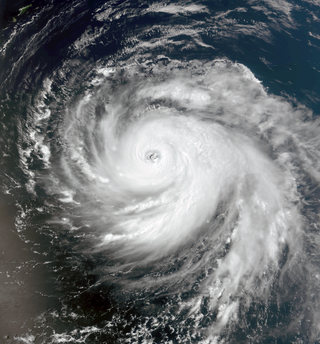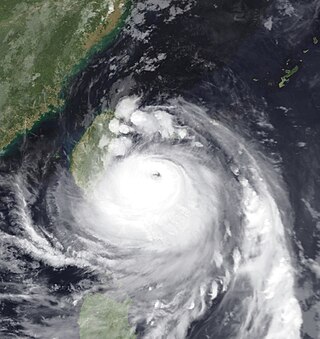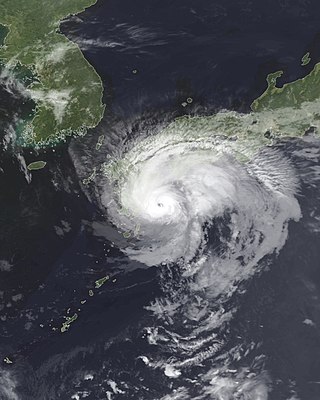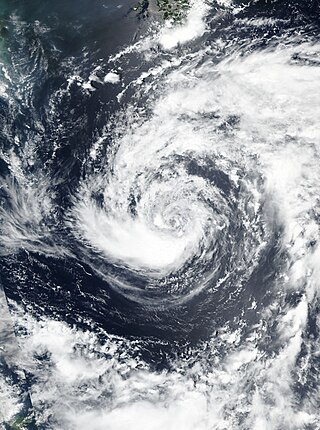
The 2018 Pacific typhoon season was at the time, the costliest Pacific typhoon season on record, until the record was beaten by the following year. The season was well above-average, producing 29 storms, 13 typhoons, and 7 super typhoons. It was an event in the annual cycle of tropical cyclone formation, in which tropical cyclones form in the western Pacific Ocean. The season ran throughout 2018, though most tropical cyclones typically develop between May and October. The season's first named storm, Bolaven, developed on January 3, while the season's last named storm, Man-yi, dissipated on November 28. The season's first typhoon, Jelawat, reached typhoon status on March 29, and became the first super typhoon of the year on the next day.

The 2019 Pacific typhoon season was the costliest Pacific typhoon season on record, just ahead of the previous year. The season featured fairly above-average tropical cyclone activity for the second consecutive year, producing 29 named storms, 17 typhoons, and five super typhoons. The season's first named storm, Pabuk, reached tropical storm status on January 1, becoming the earliest-forming tropical storm of the western Pacific Ocean on record, breaking the previous record that was held by Typhoon Alice in 1979. The season's first typhoon, Wutip, reached typhoon status on February 20. Wutip further intensified into a super typhoon on February 23, becoming the strongest February typhoon on record, and the strongest tropical cyclone recorded in February in the Northern Hemisphere. The season's last named storm, Phanfone, dissipated on December 29 after it made landfall in the Philippines.

Typhoon Bolaven, known in the Philippines as Typhoon Julian, was regarded as the most powerful storm to strike the Korean Peninsula in nearly a decade, with wind gusts measured up to 186 km/h (116 mph). Forming as a tropical depression on August 19, 2012, to the southwest of the Mariana Islands, Bolaven steadily intensified as it slowly moved west-northwestward in a region favoring tropical development. The system was soon upgraded to a tropical storm less than a day after formation and further to a typhoon by August 21. Strengthening became more gradual thereafter as Bolaven grew in size. On August 24, the system attained its peak intensity, with winds of 185 km/h (115 mph) and a barometric pressure of 910 mbar. Weakening only slightly, the storm passed directly over Okinawa on August 26 as it began accelerating toward the north. Steady weakening continued as Bolaven approached the Korean Peninsula and it eventually made landfall in North Korea late on August 28 before transitioning into an extratropical cyclone. The remnants rapidly tracked northeastward over the Russian Far East before turning eastward and were last noted on September 1 crossing the International Dateline.

Typhoon Soulik, known in the Philippines as Typhoon Huaning, was a powerful tropical cyclone that caused widespread damage in Taiwan and East China in July 2013. The storm originated from an upper-level cold-core low well to the northeast of Guam on July 6. Gaining tropical characteristics, the system soon developed a surface low and became a tropical depression early on July 7. Tracking generally westward, a motion it would retain for its entire existence, the depression underwent a period of rapid intensification starting on July 8 that culminated in Soulik attaining its peak strength early on July 10. At that time, the system had sustained winds estimated at 185 km/h (115 mph) and barometric pressure of 925 mbar. Thereafter, an eyewall replacement cycle and cooler waters weakened the system. Though it passed over the warm waters of the Kuroshio Current the following day, dry air soon impinged upon the typhoon. Soulik later made landfall late on July 12 in northern Taiwan before degrading to a tropical storm. Briefly emerging over the Taiwan Strait, the storm moved onshore for a second time in Fujian on July 13. The system was last noted as a tropical depression early on July 14.

Typhoon Lekima was the second most intense tropical cyclone worldwide in 2013, as well as the twenty-ninth named storm and the eleventh typhoon of the annual typhoon season. It developed into a tropical storm late on October 20. After Lekima intensified into a typhoon and underwent rapid deepening in a very favorable environment on October 22, the system reached peak intensity on the following day. Maintaining its strength for over one day, Lekima began to weaken on October 24, as stronger vertical wind shear and mid-latitude westerlies began to make the typhoon significantly decay. On October 26, Lekima transitioned into an extratropical cyclone east of Japan.

Typhoon Neoguri, known in the Philippines as Typhoon Florita, was a large and powerful tropical cyclone which struck Japan in 2014. The eighth named storm and the second typhoon of the annual typhoon season, Neoguri developed into a tropical storm on July 3 and then a typhoon on July 4. It rapidly deepened on July 5, reaching peak intensity late on July 6. Neoguri began to decay on July 7 and passed through Okinawa on July 8 and then making landfall over Kyushu as a severe tropical storm late on July 9. After Neoguri passed through the southern coast of Honshū on July 10, it became extratropical on July 11.

Typhoon Vongfong, known in the Philippines as Super Typhoon Ompong, was the most intense tropical cyclone worldwide in 2014, and struck Japan as a large tropical system. It also indirectly affected the Philippines and Taiwan. Vongfong was the nineteenth named storm and the ninth typhoon of the 2014 Pacific typhoon season. Estimates assess damage from Vongfong to have been over US$160 million, mainly for striking mainland Japan. At least 9 people were killed along the path of the typhoon in those countries.

Typhoon Halola, known in the Philippines as Typhoon Goring, was a small but long-lived tropical cyclone in July 2015 that traveled 7,640 km (4,750 mi) across the Pacific Ocean. The fifth named storm of the 2015 Pacific hurricane season, Halola originated from a Western Pacific monsoon trough that had expanded into the Central Pacific by July 5. Over the next several days, the system waxed and waned due to changes in wind shear before organizing into a tropical depression on July 10 while well southwest of Hawaii. The depression strengthened into Tropical Storm Halola on the next day as it traveled westward. Halola crossed the International Date Line on July 13 and entered the Western Pacific, where it was immediately recognized as a severe tropical storm. The storm further strengthened into a typhoon over the next day before encountering strong wind shear on July 16, upon which it quickly weakened into a tropical depression as it passed south of Wake Island. However, the shear relaxed on July 19, allowing Halola to reintensify. On July 21, Halola regained typhoon status and later peaked with 10-minute sustained winds of 150 km/h (93 mph) and a minimum pressure of 955 hPa. From July 23 onward, increasing wind shear and dry air caused Halola to weaken slowly. The system fell below typhoon intensity on July 25 as it began to recurve northwards. Halola made landfall over Kyushu on July 26 as a tropical storm and dissipated in the Tsushima Strait shortly after.

Typhoon Mindulle was a strong tropical cyclone which affected Japan in late August 2016. It was the ninth named storm and the second typhoon of the annual typhoon season in 2016.

Typhoon Malakas, known in the Philippines as Typhoon Gener, was a powerful tropical cyclone which affected Taiwan and Japan in mid September 2016. It was the sixteenth named storm and the sixth typhoon of the annual typhoon season in 2016.

Typhoon Nesat, known in the Philippines as Typhoon Gorio, was a strong tropical cyclone that impacted Taiwan and Fujian, China. It was the ninth named storm and the second typhoon of the annual typhoon season. After consolidating slowly for several days, Tropical Storm Nesat developed east of the Philippines on July 25. While experiencing favorable environmental conditions such as very warm sea surface temperatures and low wind shear, Nesat strengthened into a typhoon and reached its peak intensity on July 28. On July 29, the typhoon made landfall near the Taiwanese city of Yilan, before weakening to a severe tropical storm and making landfall again near Fuqing on China's east coast late the same day. Moving into July 30, Nesat continued to weaken under the effects of land interaction.

Typhoon Jongdari was a strong, long-lived and erratic tropical cyclone that impacted Japan and East China in late July and early August 2018. Formed as the twelfth named storm of the 2018 typhoon season near Okinotorishima on July 24, Jongdari gradually intensified and developed into the fourth typhoon of the year on July 26. Influenced by an upper-level low and a subtropical ridge, Jongdari executed a rare counter-clockwise southeast of Japan on the next day. At that time, it also reached peak intensity. The typhoon made landfall in Kii Peninsula, over Mie Prefecture of Japan locally early on July 29.

Typhoon Jebi, known in the Philippines as Super Typhoon Maymay, was the costliest typhoon in Japan's history in terms of insured losses. Jebi formed from a tropical disturbance south-southwest of Wake Island on August 26 and became the twenty-first named storm of the 2018 Pacific typhoon season on August 27. Amid favorable environmental conditions, Jebi quickly strengthened into a typhoon on August 29 as it headed west and rapidly intensified as it passed the Northern Mariana Islands on August 30. Jebi reached its peak intensity as a Category 5-equivalent typhoon on August 31, with 10-minute sustained winds of 195 km/h (120 mph), 1-minute sustained winds of 285 km/h (180 mph), and a minimum pressure of 915 hPa. Afterwards, Jebi began a slow weakening trend as it turned northwest, briefly passing through the Philippine Area of Responsibility on September 2. Jebi accelerated north-northeast towards Japan on September 3 as it interacted with the westerlies, and made landfalls over Shikoku and near Kobe early on September 4. Jebi quickly weakened over land and became an extratropical cyclone later that day over the Sea of Japan. Its remnants moved over the Russian Far East before dissipating on September 9.

Typhoon Francisco was a small tropical cyclone that impacted Japan and the Korean Peninsula in August 2019. Originating from a trough over the open Pacific Ocean on July 29, Francisco developed into a tropical depression on August 1. Tracking along a northwest course toward Japan, the system steadily intensified over the following days. It attained typhoon strength on August 5 and soon struck Kyushu at peak strength with winds of 130 km/h (80 mph). Thereafter, the weakened storm traversed the Korea Strait before striking South Korea on August 6. Turning toward the east, Francisco transitioned into an extratropical cyclone on August 7. It later impacted Hokkaido before continuing across the northern Pacific and dissipating.

Severe Tropical Storm Ampil, known in the Philippines as Severe Tropical Storm Inday, was a tropical cyclone that caused moderate damage in the Ryukyu Islands and East and Northeast China in late July 2018. The tenth named storm of the annual typhoon season, Ampil developed into a tropical depression east of Luzon on July 17. The system gradually strengthened over the following days amid a marginally favorable environment and became a severe tropical storm late on July 19 as it moved northwest. Maintaining its strength, Ampil passed over Okinawa Island from July 20 to 21. Thereafter, Ampil weakened slightly while crossing the East China Sea, before making landfall in Shanghai, China, on July 22. The system weakened slowly over land and degraded to a tropical depression on July 23. The system turned eastwards as it continued weakening over land, diminishing to a remnant low on July 25 and dissipating fully a day later over the Russian Far East.

Severe Tropical Storm Maliksi, known in the Philippines as Severe Tropical Storm Domeng, was a tropical cyclone in June 2018 that brought rainfall to the Philippines and Japan. It caused 2 deaths and prompted the PAGASA to declare the beginning of the rainy season in the Philippines. The fifth named storm and 4th tropical cyclone in the Philippine Area of Responsibility (PAR), it was first noted as an area of convection in the South of Palau on May 31.

Typhoon In-fa, known in the Philippines as Typhoon Fabian, was a very large and costly tropical cyclone that brought record amounts of rainfall to China in July 2021, becoming the second-wettest tropical cyclone ever recorded in the country. It was also the first storm to impact the city of Shanghai since Typhoon Mitag of 2019. The ninth depression, sixth tropical storm and third typhoon of the 2021 Pacific typhoon season, the system was first noted by the Joint Typhoon Warning Center as an area of low pressure, located east of the Philippines on July 14. Favorable conditions helped the storm to intensify, becoming a tropical depression, two days later and a tropical storm on July 17, being assigned the name In-fa by the Japan Meteorological Agency. Located in a weak steering environment, the system struggled to organize under dry air and moderate wind shear before organizing further. It continued to move mostly westward, strengthening into a typhoon and deepening quickly. The storm struggled to organize itself significantly due to continuous dry air intrusions and its frequent motion changes. On July 21, it reached its peak intensity according to the JTWC with winds of 175 km/h (110 mph); the JMA estimated a lower numbers of 150 km/h (90 mph) on the system. Nevertheless, the system reached its minimum barometric pressure of 950 hPa (28.05 inHg), three days later after passing through the Ryukyu's. As the system entered the East China Sea, marginal conditions started to take toll on the system, with In-fa weakening steadily and slowly, until it made its consecutive landfalls over Putuo District of Zhoushan and Pinghu on July 25 and 26, respectively, as a tropical storm. For the next couple of days, the storm slowly moved inland while gradually weakening, before turning northward on July 29. Later that day, In-fa weakened into a remnant low over northern China. The remnants continued their northward trek for another couple of days, before dissipating near North Korea on July 31.

Tropical Storm Lupit, known in the Philippines as Tropical Storm Huaning, was a tropical cyclone that affected Hong Kong and Macau, while also impacting the Guangdong and Fujian provinces in Mainland China, Taiwan and Japan in early-August 2021. The ninth named storm of the 2021 Pacific typhoon season, the system was first tracked as a tropical depression by the Japan Meteorological Agency (JMA) as a tropical depression over Zhanjiang. It then moved east-northeastward, affecting Hong Kong and Macau before strengthening to a tropical storm, whereas it was named Lupit. On August 5, as it neared the coast of Guangdong Province, it slightly intensified before the storm made two consecutive landfalls over Nan'ao County in Guangdong and Dongshan County in Fujian on that day. It then turned towards Taiwan before striking the northern part of the country. After lashing the area with torrential rainfall that led to numerous landslides and unknown damages, it approached and made two consecutive landfalls at mainland Japan before entering the Sea of Japan, in where it became extratropical.

Severe Tropical Storm Kompasu, known in the Philippines as Severe Tropical Storm Maring was a very large and deadly tropical cyclone that affected the Philippines, Taiwan, and southeast China. Part of the 2021 Pacific typhoon season, Kompasu originated from an area of low pressure east of the Philippines on 6 October 2021. The Japan Meteorological Agency (JMA) classified it as a tropical depression that day. A day later, the Philippine Atmospheric, Geophysical and Astronomical Services Administration (PAGASA) classified it as a tropical depression, naming it Maring. The cyclone was initially heavily disorganised, competing with another vortex, Tropical Depression Nando. Eventually, Maring became dominant, and the JMA reclassified it as a tropical storm, naming it Kompasu. Kompasu made landfall in Cagayan, Philippines, on 11 October 2021, and two days later, the storm made landfall in Hainan, China. The cyclone dissipated on 14 October 2021 while located over Vietnam.























